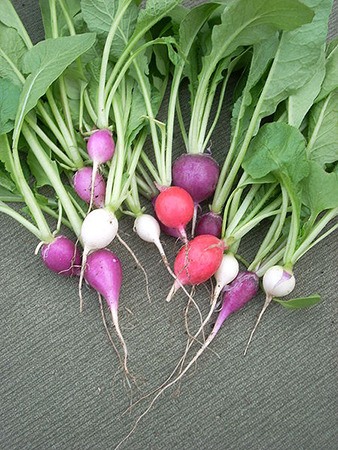Need a rapid reward for your gardening efforts? Plant radishes for a quick and easy harvest that livens up foods with its spiciness and crunch.
The radish is an edible root vegetable in the mustard family that is grown around the world. The exact origin is unknown, but is believed to be somewhere in western Asia or Europe.
The scientific name for radish (Raphanus sativus) derives from the Greek meaning “quickly appearing,” a most appropriate label for this vegetable. Radishes grow super-fast! They germinate in three-seven days and are often ready for harvest in less than a month.
Radishes come in a multitude of sizes, shapes, and colors with both quick-growing spring varieties and larger winter varieties that take several months to mature.
Radishes are easy to grow. They need full sun and rarely require supplemental fertilizer. Avoid planting them in overly rich soils that encourage lush foliage at the expense of the roots. Before planting, turn the soil to a depth of at least 8 inches.
Plant radish seeds ¼ to ½ -inch deep. Although the seeds are small, try to plant them at least an inch apart to give them plenty of room to grow. After the radishes sprout, thin them so they are at least two inches apart. Larger winter varieties need more space, so check the seed packet for thinning instructions.
Keep your radishes well watered. Radishes mature quickly, so check your planting frequently. As the radishes grow, you will be able to see the tops of their roots peeking above the soil from which you can estimate their size.
When the roots are about one inch in diameter, pull your radishes, whether you plan to use them immediately or not. Unlike many root vegetables, radishes cannot be left in the ground because they will crack and become tough, if not harvested quickly.
Radishes can be stored in a plastic bag in the refrigerator for two to three weeks. Cutting off the green tops or adding a wet paper towel to the bag will help keep the roots crisp by retaining moisture.
Taste explosion
Radishes have a spicy flavor and a crunchy texture, making them a popular addition to salads and vegetable trays. But they are more versatile than many realize. The leaves can be used in soups, as cooked greens, and in pesto. The roots can be sliced into stir-fries, grated into slaw, or diced into egg and potato salads. For a real treat, try the adjacent recipe. Radishes love cool weather. Plant spring varieties as soon as you can get into the garden in March or April. Make small weekly sowings (instead of one large sowing) so that you are not overwhelmed with too many radishes at one time.
When the weather reaches an average of 65 degrees or warmer, stop sowing radishes because the plants will go to seed. Resume planting in mid-July and early August with winter varieties as well as spring varieties for a fall harvest.
Edamame Salad with Radishes
Ingredients:
1 bag (16 oz.) frozen shelled edamame (green soybeans), thawed
1 bunch radishes (8 oz.)
¼ cup seasoned rice vinegar
1 Tablespoon vegetable oil
¼ teaspoon salt
1/8 teaspoonfreshly ground black pepper
1 cup loosely packed chopped fresh cilantro leaves – optional
Toss all ingredients together in a large bowl. Serve chilled or at room temperature. If edamame is not readily available, you may substitute chick peas. You can also just use your favorite vinaigrette dressing in place of the vinegar, oil, salt and pepper. Makes 4 servings.
— Rita Dinger, Clallam County Master Gardener
Radish Cucumber Pico de Gallo
Ingredients: (amount will vary depending on desired batch size and taste)
1 bunch radish
1 medium tomato
Lemon/lime juice to taste
1 medium cucumber
1 cup cilantro–chopped
Salt & black pepper to taste
1 cup finely chopped sweet onion
Coarsely chop radish, cucumber and tomato to desired size; place all vegetables in a large bowl (leave room to mix). Add lemon juice, salt and black pepper to taste, serve with corn chips. For additional flavor, add chopped jalapeños, dried oregano and/or avocado.
— Bick Hang, WSU Snohomish County Extension
Jeanette Stehr-Green is a Washington State University-certified, Clallam County Master Gardener.



